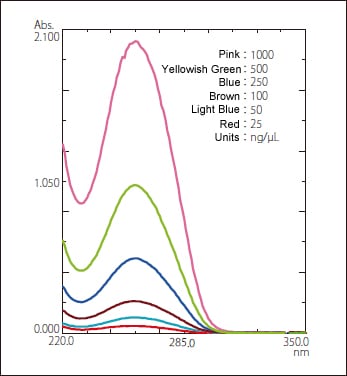Trace Quantity Measurement System - Applications

Most of the documents on the LITERATURE is available in PDF format. You will need Adobe Acrobat Reader to open and read PDF documents. If you do not already have Acrobat Reader, you can download it free at the Adobe's Website. Click the GET ADOBE READER icon on the left to download a free copy of Adobe Acrobat Reader.
Sample Analysis
Quantitation of Trace Quantities of Nucleic Acids

Samples of nucleic acids and proteins are often only available in small quantities. Accordingly, cells capable of trace quantity measurements are required. In this example, trace quantity measurements of nucleic acids were performed using a TrayCell™ with an optical path length of 1.0 mm, which allows measurements with sample volumes of 3 to 5 μL.
Lambda-DNA, a type of double stranded DNA often utilized in nucleic acid analysis, was analyzed.
A 1.0 Abs concentration sample was measured repeatedly 10 times with good precision, as follows:
The standard deviation was 0.014629 with a CV of 1.34 %.
The calibration curve formula was Y = 0.00201x + 0.00827, and the correlation coefficient was r2 = 0.99989.
Overlaid Spectra for Nucleic Acids with Different Concentrations


